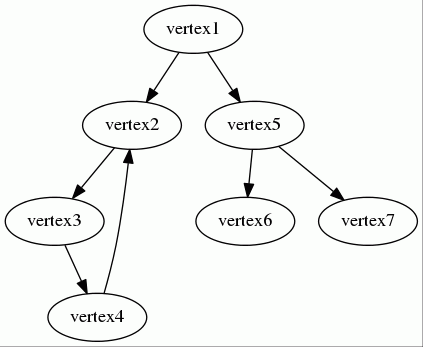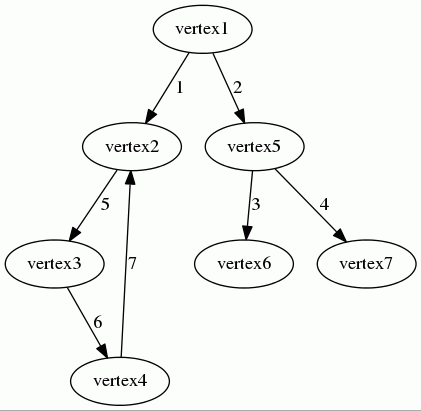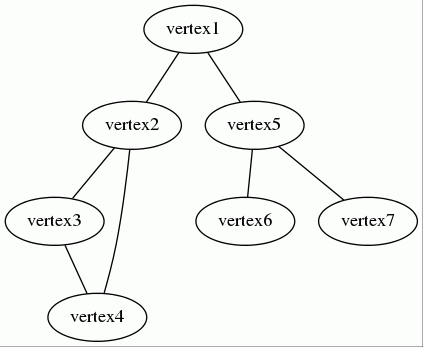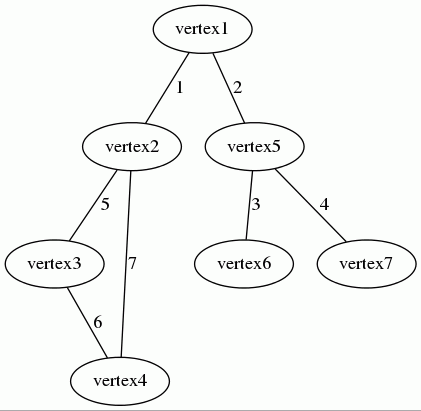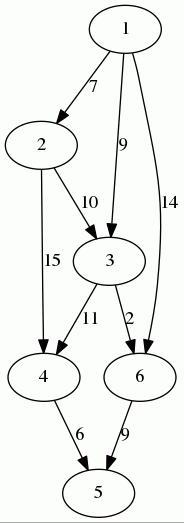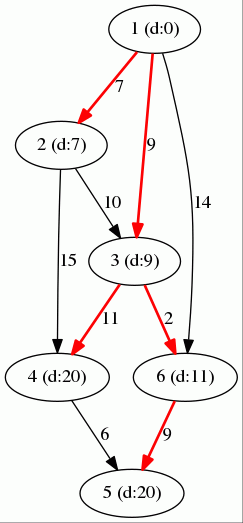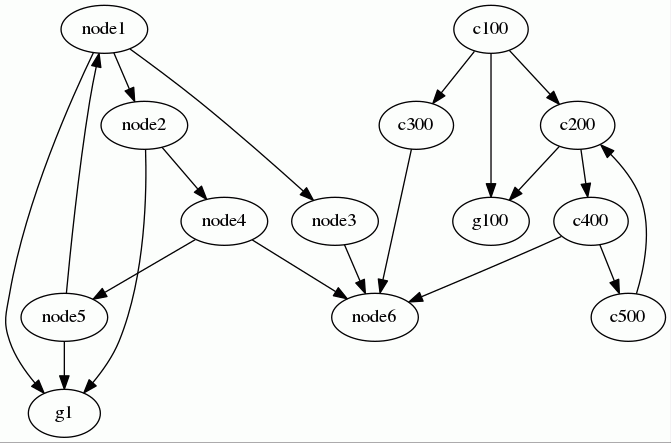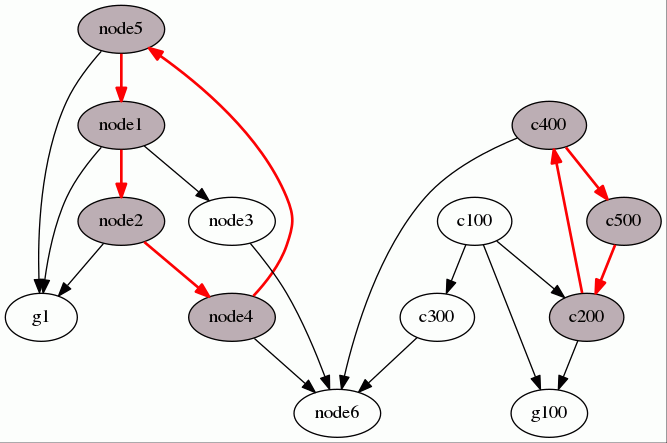dbeurive / graph
This package contains the implementation of various graphs' algorithms
Installs: 26
Dependents: 0
Suggesters: 0
Security: 0
Stars: 0
Watchers: 1
Forks: 0
Open Issues: 0
pkg:composer/dbeurive/graph
Requires (Dev)
- phpunit/phpunit: >=5.5.0
This package is not auto-updated.
Last update: 2025-12-15 21:02:45 UTC
README
- Introduction
- License
- Installation
- Graphs' types
- Graphs' representations
- Graphs' API
- Using the algorithms
Introduction
This repository contains the implementations of various algorithms for graphs.
- The breadth-first search algorithm
- The depth-first search algorithm
- The Dijkstra's algorithm
- The Tarjan's strongly connected components algorithm
License
This code is published under the following license:
Creative Common Attribution-NonCommercial 4.0 International (CC BY-NC 4.0)
See the file LICENSE.TXT
Installation
From the command line:
composer require dbeurive/graph
Or, from within the file composer.json:
"require": {
"dbeurive/graph": "*"
}
Graphs' types
Graphs may be:
- Directed or not.
- Weighted or not.
A given graph may be:
| Type of graph | Class |
|---|---|
| Directed and unweighted | \dbeurive\Graph\lists\DirectedUnweighted |
| Directed and weighted | \dbeurive\Graph\lists\DirectedWeighted |
| Undirected and unweighted | \dbeurive\Graph\lists\UndirectedUnweighted |
| Undirected and weighted | \dbeurive\Graph\lists\UndirectedWeighted |
Graphs' representations
Many formalisms may be used to represent a graph. For example:
- Edge lists
- Adjacency matrices
- Adjacency lists
This document presents various ways used to represent graphs:
This PHP module uses the formalism known as "Adjacency lists".
Directed graphs
Vertices have successors (and predecessors).
We can choose to describe the graph through its lists of successors or through its lists of predecessors.
Directed and unweighted
Let's consider the following directed unweighted graph:
The agency lists can be represented by the associative array below:
array( 'vertex1' => array('vertex2' => null, 'vertex5' => null), 'vertex5' => array('vertex6' => null, 'vertex7' => null), 'vertex2' => array('vertex3' => null), 'vertex3' => array('vertex4' => null), 'vertex4' => array('vertex2' => null) )
Or by a CSV file:
vertex1 vertex2 vertex5
vertex5 vertex6 vertex7
vertex2 vertex3
vertex3 vertex4
vertex4 vertex2
- The vertex
vertex1has two successors:vertex2andvertex5. - The vertex
vertex2has one successor:vertex3. - ...
See this example.
Directed and weighted
Let's consider the following directed weighted graph:
The agency lists can be represented by the associative array below:
array( 'vertex1' => array('vertex2' => 1, 'vertex5' => 2), 'vertex5' => array('vertex6' => 3, 'vertex7' => 4), 'vertex2' => array('vertex3' => 5), 'vertex3' => array('vertex4' => 6), 'vertex4' => array('vertex2' => 7) )
Or by a CSV file:
vertex1 vertex2:1 vertex5:2
vertex5 vertex6:3 vertex7:4
vertex2 vertex3:5
vertex3 vertex4:6
vertex4 vertex2:7
- The vertex
vertex1has two successors:vertex2andvertex5.- The weight associated to the edge from
vertex1tovertex2is 1. - The weight associated to the edge from
vertex1tovertex5is 2.
- The weight associated to the edge from
- The vertex
vertex2has one successor:vertex3.- The weight associated to the edge from
vertex2tovertex3is 5.
- The weight associated to the edge from
- ...
See this example.
Undirected graphs
Vertices have neighbours.
Undirected and unweighted
Let's consider the following undirected unweighted graph:
The agency lists can be represented by the associative array below:
array( 'vertex1' => array('vertex2' => null, 'vertex5' => null), 'vertex5' => array('vertex6' => null, 'vertex7' => null), 'vertex2' => array('vertex3' => null), 'vertex3' => array('vertex4' => null), 'vertex4' => array('vertex2' => null) );
Or by the CV file:
vertex1 vertex2 vertex5
vertex5 vertex6 vertex7
vertex2 vertex3
vertex3 vertex4
vertex4 vertex2
- The vertex
vertex1has two neighbours:vertex2andvertex5. - The vertex
vertex1has two neighbours:vertex6andvertex7. - ...
See this example.
Undirected and weighted
Let's consider the following undirected weighted graph:
The agency lists can be represented by the associative array below:
array( 'vertex1' => array('vertex2' => 1, 'vertex5' => 2), 'vertex5' => array('vertex6' => 3, 'vertex7' => 4), 'vertex2' => array('vertex3' => 5), 'vertex3' => array('vertex4' => 6), 'vertex4' => array('vertex2' => 7) );
Or by the CSV file:
vertex1 vertex2:1 vertex5:2
vertex5 vertex6:3 vertex7:4
vertex2 vertex3:5
vertex3 vertex4:6
vertex4 vertex2:7
- The vertex
vertex1has two successors:vertex2andvertex5.- The weight associated to the edge from
vertex1tovertex2is 1. - The weight associated to the edge from
vertex1tovertex5is 2.
- The weight associated to the edge from
- The vertex
vertex2has one successor:vertex3.- The weight associated to the edge from
vertex2tovertex3is 5.
- The weight associated to the edge from
- ...
See this example.
Graphs' API
Introduction
The graph's API allows the following actions:
- Load a graph from a CSV file.
- Dump a graph into a CSV file.
- Create the GraphViz representation of a graph.
- "Complete" a graph's representation.
- For directed graphs: calculate the lists of predecessors from the lists of successors and vice versa.
Instead of presenting an-in depth description of the API, we will show examples of uses.
Detailed API description can be generated using phpDocumentor. Just go to the root directory of this package and issue the following command:
phpdoc. The documentation will be generated within the directorydoc/api.
Loading a graph from a CSV file
Loading CSV with the default loader
Synopsis:
$graph = new DirectedUnweighted(); // or DirectedWeighted $graph->loadSuccessorsFromCsv($csvSuccessorsPath); $graph->loadPredecessorsFromCsv($csvPredecessorsPath); $graph = new UndirectedUnweighted(); // or UndirectedWeighted $graph->loadNeighboursFromCsv($csvSuccessorsPath);
By default:
- Fields are separated by a space.
- Edges' weight is indicated by the character ':'.
- Vertices' names are loaded "as is".
Examples of standard CSV files:
vertex1
vertex2 vertex1 vertex4
vertex5 vertex1
vertex6 vertex5
vertex7 vertex5
vertex3 vertex2
vertex4 vertex3
or:
vertex1
vertex2 vertex1:1 vertex4:7
vertex5 vertex1:2
vertex6 vertex5:3
vertex7 vertex5:4
vertex3 vertex2:5
vertex4 vertex3:6
See example from-csv-directed-unweighted.php.
See example from-csv-directed-weighted.php.
See example from-csv-undirected-unweighted.php.
See example from-csv-undirected-weighted.php.
Loading CSV with a customized loader
Synopsis:
$graph = new DirectedUnweighted(); // or UndirectedUnweighted $graph->setFieldSeparator(';'); $graph->setVertexUnserializer(function($inVertex) { return strtoupper($inVertex); }); $graph->setLinePreProcessor(function($inLine) { return trim($inLine); }); $graph = new DirectedWeighted(); // or UndirectedWeighted $graph->setFieldSeparator(';'); $graph->setVertexUnserializer(function($inVertex) { return strtoupper($inVertex); }); $graph->setLinePreProcessor(function($inLine) { return trim($inLine); }); $graph->setWeightIndicator('::');
While loading CSV files, it is possible to specify non-standard attributes:
- The field separator. The default field separator is the space (" ").
- The weight indicator (for weighted graphs only). The default weight indicator is the character ":".
It is also possible to specify actions applied to the following data:
- The vertices' names.
- The line of CSV (for example, you can remove leading and trailing spaces).
Actions are specified via a "callable" (see this explanation).
In the following examples:
- We changed the field separator (we use ";" instead of " ").
- We changed the weight indicator (we used "::" instead of ":").
- We convert vertices' names into uppercase.
- We remove leading and trailing spaces from each line before any other process.
See example from-csv-directed-unweighted-non-standard.php.
See example from-csv-directed-weighted-non-standard.php.
Dumping a graph into a CSV file
Dumping into CSV with the default dumper
Synopsis:
$graph = new DirectedUnweighted(); // Or DirectedWeighted $graph->setSuccessors($listOfSuccessors); // You can also set the lists of predecessors. $graph->dumpSuccessorsToCsv($csvPath); // You can also dump the lists of predecessors. $graph = new UndirectedUnweighted(); // Or UndirectedWeighted $graph->setNeighbours($listOfNeighbours); $graph->dumpNeighboursToCsv($csvPath);
See example to-csv-directed-unweighted.php.
See example to-csv-directed-weighted.php.
See example to-csv-undirected-unweighted.php.
See example to-csv-undirected-weighted.php.
Dumping into CSV with a customized dumper
Synopsis:
// Directed Weighted $graph = new DirectedWeighted(); $graph->setSuccessors($listOfSuccessors); $graph->calculatePredecessorsFromSuccessors(); $graph->setFieldSeparator(';'); $graph->setVertexSerializer(function($inVertex) { return strtoupper($inVertex); }); $graph->setWeightIndicator('::'); $graph->dumpSuccessorsToCsv($csvPath); $graph->dumpPredecessorsToCsv($csvPath); // Directed Unweighted $graph = new DirectedUnweighted(); $graph->setSuccessors($listOfSuccessors); $graph->calculatePredecessorsFromSuccessors(); $graph->setFieldSeparator(';'); $graph->setVertexSerializer(function($inVertex) { return strtoupper($inVertex); }); $graph->dumpSuccessorsToCsv($csvPath); $graph->dumpPredecessorsToCsv($csvPath); // Undirected Weighted $graph = new UndirectedWeighted(); $graph->setFieldSeparator(';'); $graph->setWeightIndicator('::'); $graph->setVertexSerializer(function ($inVertex) { return strtoupper($inVertex); } ); $graph->setNeighbours($listOfNeighbours); $graph->dumpNeighboursToCsv($csvPath); // Undirected Unweighted $graph = new UndirectedUnweighted(); $graph->setFieldSeparator(';'); $graph->setVertexSerializer(function ($inVertex) { return strtoupper($inVertex); } ); $graph->setNeighbours($listOfNeighbours); $graph->dumpNeighboursToCsv($csvPath);
While dumping CSV files, it is possible to specify non-standard attributes:
- The field separator. The default field separator is the space (" ").
- The weight indicator (for weighted graphs only). The default weight indicator is the character ":".
It is also possible to specify actions applied to the following data:
- The vertices' names.
Actions are specified via a "callable" (see this explanation).
See example to-csv-directed-unweighted-non-standard.php.
See example to-csv-directed-weighted-non-standard.php.
See example to-csv-undirected-unweighted-non-standard.php.
See example to-csv-undirected-weighted-non-standard.php.
Dumping a graph into its GraphViz representation
Synopsis:
$graph = new DirectedUnweighted(); // or DirectedWeighted $graph->setSuccessors($listOfSuccessors); $txt = $graph->dumpSuccessorsToGraphviz(); $graph->calculatePredecessorsFromSuccessors(); $txt = $graph->dumpPredecessorsToGraphviz(); $graph = new UndirectedUnweighted(); // or UndirectedWeighted $graph->setNeighbours($listOfNeighbours); $txt = $graph->dumpNeighboursToGraphviz();
Please note that the generated GraphViz representation is highly customisable. The methods
dumpSuccessorsToGraphviz,dumpPredecessorsToGraphvizanddumpNeighboursToGraphviztake parameters. These parameters allow you to customise the appearances of the vertices and of the edges.
See example to-graphviz-directed-unweighted.php.
See example to-graphviz-directed-weighted.php.
See example to-graphviz-undirected-unweighted.php.
See example to-graphviz-undirected-weighted.php.
Using the algorithms
The "Breadth First Search" algorithm
See the description here.
Synopsis
$vertices = array(); // Define a callback that will be executed for each visited vertex. // * If the function returns true, then the exploration of the graph continues. // * If the function returns false, then the exploration of the graph ends. $callback = function($inVertex) use(&$vertices) { $vertices[] = $inVertex; return true; }; // For directed graphs $graph = new DirectedUnweighted(); // or DirectedWeighted $graph->setSuccessors($successors, true); $graph->calculatePredecessorsFromSuccessors(); $algo = new DirectedBreadthFirstSearch($graph, $callback); $algo->followSuccessors(); $algo->run('e1', $callback); // Start traversing the graph from the vertex 'e1', following the sucessors. $algo->followPredecessors(); $algo->run('e1', $callback); // Start traversing the graph from the vertex 'e1', following the predecessors. // For undirected graphs $graph = new UndirectedUnweighted(); // or UndirectedWeighted $graph->setNeighbours($successors, true); $algorithm = new UndirectedBreadthFirstSearch($graph, $callback); $algorithm->run('e1', $callback); // Start traversing the graph.
Please note that this algorithm works for directed and undirected graphs.
Please note that the returned value of the callback function (
$callback) determines the behaviour of the methodrun().
- If the callback function returns the value true, then the method
run()continues the traversal of the graph.- If the callback function returns the value false, then the method
run()stops the traversal of the graph.
See example breadth-first-search-directed.php.
See example breadth-first-search-undirected.php.
The "Depth First Search" algorithm
See the description here.
Synopsis
$vertices = array(); // Define a callback that will be executed for each visited vertex. // * If the function returns true, then the exploration of the graph continues. // * If the function returns false, then the exploration of the graph ends. $callback = function($inVertex) use(&$vertices) { $vertices[] = $inVertex; return true; }; // For directed graphs $graph = new DirectedUnweighted(); // Or DirectedWeighted $graph->setSuccessors($successors, true); $graph->calculatePredecessorsFromSuccessors(); $algo = new DirectedDepthFirstSearch($graph, $callback); $algo->followSuccessors(); $algo->run('e1', $callback); // Start traversing the graph from the vertex 'e1', following the successors. $algo->followPredecessors(); $algo->run('e1', $callback); // Start traversing the graph from the vertex 'e1', following the predecessors.
Please note that this algorithm works for directed and undirected graphs.
Please note that the returned value of the callback function (
$callback) determines the behaviour of the methodrun().
- If the callback function returns the value true, then the method
run()continues the traversal of the graph.- If the callback function returns the value false, then the method
run()stops the traversal of the graph.
See example depth-first-search-directed.php.
See example depth-first-search-undirected.php.
The Dijkstra's algorithm
See the description here.
- This algorithm works for both directed and undirected graphs.
- The graph must be weighted.
Synopsis
// With directed graphs $graph = new DirectedWeighted(); $graph->setSuccessors($successors, true); $algorithm = new DirectedDijkstra($graph); $algorithm->followSuccessors(); $distances = $algorithm->run($vertexName); // Start the algorithm. $txt = $algorithm->dumpToGraphviz(); // For a nice representation of the result. // With undirected graphs $graph = new UndirectedWeighted(); $graph->setNeighbours($neighbours, true); $algorithm = new UndirectedDijkstra($graph); $distances = $algorithm->run($vertexName); $txt = $algorithm->dumpToGraphviz(); // For a nice representation of the result.
See example dijkstra-directed.php.
See example dijkstra-undirected.php.
Illustration
Given the graph below, let's find the shortest paths from the vertex "1" to all other vertices.
After running the algorithm, we get:
- The shortest distance between vertex "
1" and vertex "3" is 9. - The shortest distance between vertex "
1" and vertex "6" is 11. - The shortest distance between vertex "
1" and vertex "5" is 20. - ...
Shortest paths are printed in red.
The Tarjan's algorithm
See the description here.
- This algorithm works for both directed graphs only.
- The graph may be weighted or not.
Synopsis
$graph = new DirectedUnweighted(); // or DirectedWeighted $graph->setSuccessors($successors, true); $algorithm = new DirectedTarjan($graph); $algorithm->followSuccessors(); $scc = $algorithm->run(); $cycles = $algorithm->getCycles(); $txt = $algorithm->dumpToGraphviz(); // For a nice representation of the result.
See example tarjan.php.
Illustration
Given the graph below, let's find all the cycles:
After running the algorithm, we get:
Please note that this algorithm does not return the list of cycles within the graph. It returns the list of strongly connected components. However, cycle detection is an application of this algorithm. Here, we choose to show the result of the method
getCycles().

